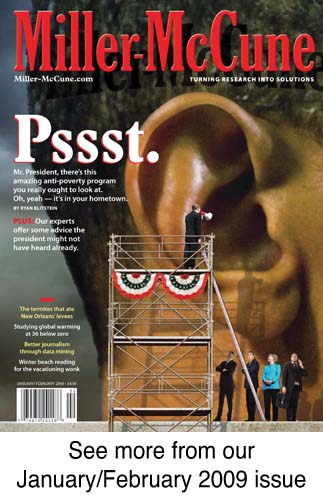Tennis referees are not universally beloved figures. (Just ask John McEnroe; he’s still yelling, “You can’t be serious!” over a point he lost in 1981.) But are bad calls really their fault? New research in Current Biology, which received some press coverage in England, suggests McEnroe should have focused on inherent flaws in human vision rather than the fallibility of individual refs.
Scientists have long known that the human eye often misperceives moving objects and shifts them in the direction of their motion so the objects appear to be farther along their path than they really are. David Whitney, of the Center for Mind and Brain at the University of California, Davis, realized it might be possible to study this optical illusion in a real-world context after watching a Wimbledon match in which a player’s challenge overturned a referee’s call.
If tennis referees were free of visual bias, Whitney reasoned, they would make incorrect “out” and “in” calls with roughly the same consistency. So he went to the tape. And in a review of more than 4,000 randomly selected Wimbledon tennis points, Whitney’s research team discovered 83 incorrect calls; 70 of the errors were in the “out” direction, showing that visual bias was indeed affecting calls in the most prestigious competition in professional tennis.

The implications for the sport, according to the study, are legion. Now that players have the ability to challenge calls, they should focus exclusively on balls that are ruled “out” because they are much more likely to be incorrect. Whitney would also like instant replay for every shot — or at least a better method to allow players to challenge.
And McEnroe will love this: If all else fails, Whitney suggests, we should do it the French way. “Perhaps professional tennis venues should follow the French and universalize the clay court,” he says, because the skid marks left behind on the clay provide visual evidence to counterbalance the referees’ inherent perception bias.
TRANSLATION, PLEASE
The paper “Stress-Induced Neurogenic Inflammation in Murine Skin Skews Dendritic Cells Towards Maturation and Migration: Key Role of Intercellular Adhesion Molecule-1/Leukocyte Function-Associated Antigen Interactions” appears in the November 2008 issue of The American Journal of Pathology. … In other words, stress might make you itch.
GOOD NEWS FOR PINOCCHIO OR YET ANOTHER REASON TO POWDER YOUR NOSE
Perhaps the poet was right — the eyes truly are the windows to the soul — but the nose is what people notice first. That’s according to a study in the October 2008 issue of Psychological Science, which reports that the nose is the optimal viewing position for face recognition because information about the face is balanced in all directions.
In the study, which the researchers hope will help cognitive scientists design more realistic models of the brain, participants were shown images of faces they had just seen and images of faces they had never seen. While the subjects tried to decide, in an instant, whether they recognized the face, the researchers used cutting-edge eye-tracking technology to monitor where the subjects looked and how long their eyes lingered at each spot. The study found that people first look just to the left of the center of the nose and then slide to the center; these two visual “fixations” are all people need to recognize a face.
“The location of the second fixation, like the first, was almost always near the center of the nose,” said Garrison Cottrell, an author of the paper and a computer science professor at the University of California, San Diego’s Jacobs School of Engineering. “This means you are just shifting the face you are looking at on your retina a bit. This shift changes which neurons are firing in your retina and therefore changes the neurons in the cortex that the visual pattern goes to.”
And don’t get him started on tennis referees …
AND FINALLY, THE LAST WORD …
“There’s no way anyone’s drinking any of this until we get rid of that, not to mention that there’s only one genetically modified strain of yeast that’s ever been approved for use in beer, period. In short, it will be a long time before anybody consumes any of this.” — Rice University junior Thomas Segall-Shapiro, who for this year’s international Genetically Engineered Machine competition helped create a strain of yeast that will ferment beer and produce resveratrol (a chemical in wine that has demonstrated anti-cancer properties); the resveratrol was linked to unappetizing “chemical markers” that will render test batches of his brew undrinkable. Alas.
The Cocktail Napkin provides a look at current research that merits a raised eyebrow or a painful grin. If you have an idea to pass along, send an e-mail to theeditor@miller-mccune.com.
Sign up for our free e-newsletter.
Are you on Facebook? Become our fan.



